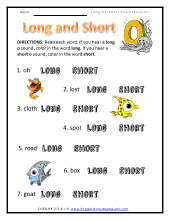Vowel Worksheets
As my second grade teacher often reminded me: A, E, I, O, and U make the English language go around. The English alphabet consists of twenty-six letters. The letters are classified into two categories by linguists: consonants and vowels. There are five letters that are always classified as vowels: a, e, i, o, and u. The letter y can function as a vowel in choice circumstances but is not considered a vowel. Every other letter in the alphabet is considered a consonant. When you pair a vowel with a consonant or group of consonants it will form a syllable. These vowel worksheets will help students better understand how vowel contribute sounds to words.
Assonance - This is a literary device that is often used in different forms of poetry. It hinges on the repetition of the vowel sounds while lacking repeating consonants.
Changing Phonemes to Make New Words - This really helps you see the similarities and familiarities that are present in word families. It also helps you solve crossword puzzles quicker.
CVC Words - We explore words such as (cat) that follow a consonant-vowel-consonant pattern. This is usually the first real language unit at the Kindergarten level.
CVCe (Silent e) - This is where you build up from the topic we just covered. These words end in the letter (e), but it does not give off any sound.
CVVC Word - These are four letter words that are packed with a blend sound in the middle.
Decoding Multisyllable Words - We show you a flexible and common-sense approach to bring these terms to speech. In most cases, these are vocabulary terms that you are unfamiliar with.
Diagraphs - This is when you have two letters that are grouped together, but they only give off one sound.
Diphthongs - This is a unique tone that is given off by two vowels that are located within the same syllable. There are thought to be classifications of them, but I have seen linguists slant that value in both directions.
Diphthong, Vowel Digraph and Pattern - These worksheets build off of the past topic, but they add another element of difficulty by analyzing sequences and patterns that may exist.
Isolate and Pronounce Phonemes - We explore phonemic awareness strategies that help students tackle words that are completely new to them.
Long A - The pack of worksheets just focus on words that exhibit this sound within them.
Long E - We move on to one of the most popular units to begin the year with for teachers.
Long I - This can be tricky unit because I find students have difficulty pronouncing these words.
Long O - You will find that the words that exhibit this sound will have eight different phonetic spellings.
Long U - This is a nice place to start when learning these types of sounds in your phonics units.
Long Vowel Sounds - Whereas the past five worksheet topics have singled out each individual sound, which look at them collectively in this topic.
R Controlled Vowels - This is when the sound is proceeded by the letter (r) and as a result the pitch of the sound is ultimately changed.
Long vs. Short Vowels - We look at letters that dictate the sounds that are focused on them. Some sound in words just like their letters and others do not.
Short Vowel Sounds - When they just do not correspond with the letter names themselves.
Short A Sound - You hear this in words like: ask, bag, gap, sad, and van.
Short E Sound - Here is a list of words that fit this pattern: bed, fed, hen, men, and wet.
Short I Sound - The words (big, did, fit, pig, and win) fall into this category.
Short O Sound - You will find this in words like: dog, hot, mom, pop, and top.
Short U Sound - The most often used example of a word that exhibits this is the word: bus.
Spelling Patterns and Generalizations - When we understand this, it can helps us pronounce new words and even spell words that we have heard of before.
Variant Vowels - These are when a series of letters, regardless of their classification, exude a tone familiar to vowels.
Vowel Team Conventions - These are common groupings of letters that actually help us identify word families.
Writing Short Vowel Sounds - This is for when you first begin to work with a phonics unit that includes these tones.
Get FREE English Worksheets In Your Email
